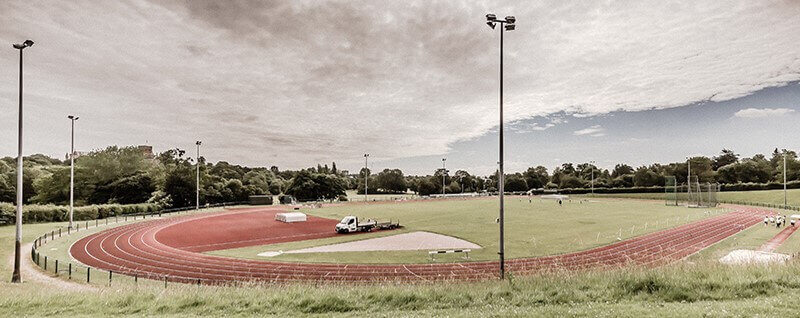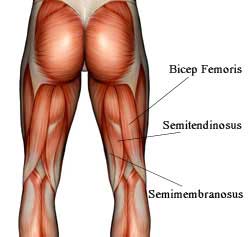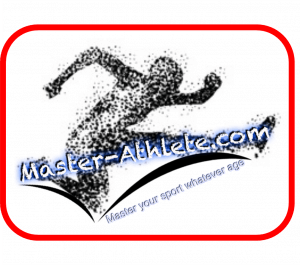Hamstring injuries! we have all had them! I personally have had some major ones, including a full Bicep Femoris Tendon Avulsion back in 2010 on my Right leg. So here we take a look at the hamstrings and how we can help prevent injury but also rehab. Here we have a 10 day programme to get you back running as soon as possible.
I tore my tendon on day 2 of a 14 day war weather training camp, by day 11 I was able to jog 1.5 miles within a further 5 weeks I was actually back to some lower level of sprinting, and that was without the use of a big chunk of hamstring functioning correctly.
What are the hamstrings?
We should probably begin by taking a look at what the hamstrings are. The hamstrings are the muscle group that runs down the back of your thigh. The hamstring muscle group is comprised of three actual muscles; biceps femoris (that has a long head and a short head), semimembranosus, and semitendinosus. The muscles group is bi-articular, which means that it works on two different joints; the hip and the knee. Specifically, the hamstrings work to extend the hip, and also flex the knee. This makes them important in sprinting because they control the lower leg movement throughout most of the stride cycle, and also assist the gluteal muscles in creating a powerful hip extension. The hamstring muscles also have a few other functions. They act as a secondary knee stabiliser and also play a role in controlling rotation of the whole leg (Koulouris et al. 2007). There is some evidence to show that the hamstrings also act as a shock absorber during foot contact in sprinting (Malliaropoulas et al 2012).
Like all muscles, the hamstrings can work both eccentrically and concentrically. Concentric muscle action is where the muscle shortens whilst it contracts, and an eccentric action is where the muscle lengthens whilst increasing tension. Eccentric actions occur with both a larger force and higher velocity than concentric actions, and so are more likely to cause injury.
During the sprint cycle, as the thigh reaches its maximum flexion angle in front of the body, the lower leg begins to escape forwards. This is crucial, as it allows the athlete to cover greater distance per stride, increasing their stride length. Whilst this lower leg is moving forwards, however, the hamstrings are working hard to control the movement. The hamstrings first slow the lower leg as it moves forward, bringing it to a stop. They do this eccentrically, because the hamstrings are lengthening throughout this movement. Once the lower leg has stopped moving forwards, it is then rapidly accelerated towards the ground. This is achieved mostly through hip extension, which requires the hamstrings to concentrically contract. The more powerful this movement, the shorter the ground contact time, which plays a role in improving stride frequency. Once the foot makes contact with the floor, the hamstrings continue to work in combination with the gluteal muscles, actively pulling the body over the foot (Mann 2011). These actions demonstrate the major contributions of the hamstring muscles during the sprint cycle.
It is easy to find volumes of information regarding training the hamstring for size, strength and appearance however training the hamstrings for sprinting is a specialized discipline. Developing healthy hamstrings for sprinting and speed work requires you pay attention to a variety of factors as well as pure strength. Here are my top four factors you MUST pay attention to:
- Train the hamstrings as extensors of the hip as the most important way to train the hamstring for sprinting (opposed to training the hamstring as a flexor of the knee)
- Regeneration and therapy performed in small amounts OFTEN opposed to large amounts infrequently
- Keep your hamstrings warm and dry in and out of training
- Electric Muscle Stimulation (EMS) can play a wide role in building and strengthening as well as rehabilitating hamstring injuries
Before we look at these factors in detail, here are two key facts to consider:
FACT ONE:
Hamstrings operate at the highest velocity (up to 88kph for elite sprinters) of any muscle group. To understand this, think that if you are running at top speed your hamstring contracts as a flexor of the hip and as your leg extends behind you in your stride, your hamstring continues to contract at more than double your top speed as it flexes the knee and recoils the lower leg before the leg starts moving forward again.
What are the implications of the speed of this muscle?
The implications of this is muscles moving at this speed makes the hamstring sensitive to injury if high intensity training is attempted with poor technique or during conditions of incomplete regeneration or overtraining”. (page 40 The Charlie Francis Training System)FACT TWO:
The hamstring is one of the largest muscles in the body. When it is tight, overworked and or trained primarily as a flexor of the knee the risk of injury increases. Large amounts of time and energy go into the rehabilitation for an athlete who has a hamstring injury.
HAMSTRINGS: EXTENSORS OF THE HIP FOR SPRINTING
The hamstring has multiple roles as flexors of the knee and extensors of the hip. For Sprinting, coaches and athletes need to focus on the following exercises:
- Half squats
- Reverse Leg Press
- Power cleans done with excellent form
- Exercises with pulleys and cables
- Explosive medicine ball drills
Easy to perform non-strength exercises that facilitate hamstring development should also be done. These are:
- leg swings
- side leg swings
- donkey kicks
- hurdle drills against the wall
TWO COMMON MISTAKES IN HOW THE HAMSTRING IS TRAINED FOR SPRINTING
- Over-training the hamstring with high volumes of large variety of lifts.
- Emphasizing strength training as a key goal instead of speed work as the key priority.
Injuries and Injury Prevention in Sprinting and Hurdle Events
REGENERATION AND THERAPY PERFORMED OFTEN
A hamstring might be strong and it might also look big and beautiful. For the hamstring to be healthy for sprinting ROUTINE regeneration done in small amounts often is most effective.
A common mistake made by coaches and athletes is avoiding therapy all together because they think it’s not needed, the thought that it is expensive or they don’t understand the importance.
Quality sprinting requires muscles rested but reactive, strong but loose, agile yet relaxed. Routine regeneration and therapy facilitate healthy hamstring development.
KEEP YOUR HAMSTRINGS WARM FOR BEST PERFORMANCE
Wearing layers of clothing to keep all of you muscles dry and warm helps speed up the process of getting appropriately warmed up to do the highest quality of work as well as the highest intensity of work.
Work to improve your method of warming up which should include routine exercises performed daily all year around including competition. (See my blog on the warm-up)
Heat can be added to hamstrings and or tighter muscles to assist in the process of getting your muscles in the best possible state for training.
Heat can be put on any muscles, wrapped in saran and then loose tensors overnight for best results.
ELECTRONIC MUSCLE STIMULATION
EMS can be used to both strengthen hamstrings and relax or massage the hamstrings. The usefulness as well as the effectiveness of this small device is invaluable.
WELLNESS FOR HAMSTRING HEALTH
- Hamstrings need to be warm to be loose and relaxed.
- Hamstrings need to be strong, but agile and balanced.
- Hamstrings need routine rest, complete regeneration to be ready for more work.
Worth also noting the role of the Neck muscles in Hamstring health, take a look HERE
Hamstring Strengthening
Going against the grain of the movement toward “functional” exercise, the structural damage of individual muscles is targeted using eccentric contractions. Eccentric hamstring exercises performed with the muscle in a stretched position are used to lengthen the shortened muscle fascicles post HSI. This is crucial to not only reducing HSI recurrence, but also in getting the athlete’s power back.
Eccentric hamstring exercises have been shown to prevent first-time and recurrent HSI. These exercises are a vital part of breaking the cycle of pain, atrophy, weakness and re-injury. The following exercises provide an eccentric contraction of the hamstring in a lengthened position:
- Nordic hamstring curl: While kneeling, lock the ankles down with a piece of gym equipment or with the hands of a helper. Slowly lower the torso forward while keeping the thighs in line with the torso. Attaching a band to the shoulders from behind is helpful in making it easier to near the floor before failure.
- Slider: Start in a standing position while holding something sturdy. Slide one foot backward as far as you can comfortably go and then use your arms to pull yourself back to standing. Try to keep only a slight bend at the knees.
- Stiff-legged deadlift: Stand with the torso straight, feet shoulder-width apart and knees slightly bent. Keeping the knees stationary, lower the torso by bending at the waist while keeping your back straight. Lower the torso forward as if you were going to pick up something from the floor until you feel a stretch on the hamstrings; then bring the torso up straight again by extending your hips until you are back at the starting position.
- Single-leg deadlift: Standing on one foot, bend forward, keeping the back straight while extending the free thigh backward at the same time. The torso and the extended thigh should stay in line and move as a unit.
Building up tolerance to eccentric loading and resilience to muscle damage is important in preseason and during the season. Of course, in-season muscle soreness and sprinting load need to be managed.
Training After a Hamstring Pull to fully Rehab
Immediately after a hamstring injury, where some muscle fibers are torn or ruptured, an ice compress should be used to stop internal bleeding.
Day 1 – The first day after the injury should be a passive rest. Depending on the level of Injury follow the RICE principle in this phase
Day 2 – The second day’s activity will depend on the extent of the injury, again depending on level follow the RICE principle.
An assessment of the next competition must be made. For the sprinter, it is usually possible within two or three weeks to have a race at 200m. This must be done with a limited 30-40m acceleration and maintenance of speed.
For the 400m runners, a 400m race in 10 to 14 days, with a limited acceleration distance of 30m from the starting blocks is usually possible. A limited acceleration distance means the athlete must be under the maximum speed without the maximum stride length. Under those circumstances, to perform well, the athlete should be in good specialized training condition to maintain the limited speed over the 200 or 400m distance.
On the second day after a hamstring pull, the athlete is able to execute the following workout:
- One Leg Marching – power speed and strength endurance where the injured leg doesn’t work.
- One Leg Skipping – power speed and strength endurance where the injured leg doesn’t work.
- One Leg Exercise – power speed and strength endurance where the injured leg doesn’t work.
Exercises without extensions, jumps and bounding. Some medicine ball exercises in sitting and lying positions in which the hamstring muscles are not actively engaged. Some weight exercises – where the hamstring isn’t actively engaged.
After 3 – 4 Days: Re-introduce Drills and easy short Jogging exercises
– Both legs marching drills
– Both legs rope skipping
– No extension – jumps or bounding
– Medicine ball exercises
– Straight Legged Weighted exercises
– Running interval for limited distances:
4 x 10m
4 x 20m
After 5 – 6 Days: Start to increase the dynamic element and speed to the “Jogging” elements
– All exercises like before plus additional eccentric weighted exercises done easily
6 x 30m Strides
Easy acceleration repetition 6 x 20m these can be from a slight crouched starting position
After 7 – 8 Days:
Workout like above and acceleration 20m and maintain limited speed 100 – 200 – 300m. Starts from starting blocks 20m.
After 9 – 10 Days:
Workout as above and starts from starting blocks 30m or 40m competition (30m acceleration)
The Following Days:
Normal training with the speed limitation. From 6-8 days, massage of injured muscle may be started.
After a few possibly good races at 200m the sprinter might compete again in the 100m.
A very interesting paper back in 1989 looked at the use of fast eccentrics as Hamstring Health, I personally also add these in regularly as part of my generic prehab
Hamstring Eccentric



